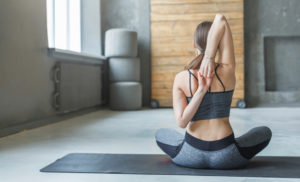by Nina
 |
| Beth in Rishi’s Posture |
You know how everyone seems to think that sitting for many hours a day is some kind of crime against your body—sitting is the new smoking, they keep saying these days—and something that is totally unnatural given our evolution as hunter-gatherers? Surely, hunter-gatherers they kept active throughout the day, right?
So it turns out that I think we’ve kind of demonized sitting a little falsely.”
by NinaBeth in Rishi’s PostureYou know how everyone seems to think that sitting for many hours a day is some kind of crime against your body—sitting is the new smoking, they keep saying these days—and something that is totally unnatural given our evolution as hunter-gatherers? Surely, hunter-gatherers they kept active throughout the day, right?Well, instead of just speculating about the behavior of hunter-gatherers, Daniel Lierberman, a professor in the department of human evolutionary biology at Harvard, spent time living with indigenous hunter-gatherers in Africa and Latin America and observing how much they exercised. He kept records about how much time they actually walked, ran, lifted, carried, and sat. (See his book Exercised for information about his findings, about the myths regarding exercise, and the importance of exercise for our health.)His findings about sitting surprised me! In the interview I heard with him on NPR Just Move: Scientist Author Debunks Myths About Exercise And Sleep, he said that he found that on average hunter-gatherers sit about 10 hours a day, so it’s actually a normal activity for us humans.“When I walk into a village in a remote part of the world where people don’t have chairs or a hunter-gatherer camp, people are always sitting. … Some friends and colleagues of mine actually put some accelerometers on some hunter-gatherers and found that they sit on average about 10 hours a day, which is pretty much the same amount of time Americans like me spend sitting.So it turns out that I think we’ve kind of demonized sitting a little falsely.”But he stresses that in addition walking around 5 miles a day, hunter-gatherers also sit differently than the way we tend to sit in first world countries. One important difference that in hunter-gatherer camps “people are getting up every few minutes, to take care of the fire or take care of a kid or something like that.” (The other is that they don’t sit on chairs that support their backs, a topic for another post, surely.)So Lieberman emphasizes the importance of “interrupted sitting,” as a much healthier way to sit because it keeps your muscles going. He explained it this way:“Just getting up every once in a while, every 10 minutes or so — just to go to the bathroom or pet your dog or make yourself a cup of tea — even though you’re not spending a lot of energy, you’re turning on your muscles. And your muscles, of course, are the largest organ in your body — and just turning them on turns down inflammation. It uses up fats in your bloodstream and sugars in your bloodstream, and it produces molecules that turn down inflammation. So the evidence is that interrupted sitting is really the best way to sit.”A while back, I actually had an epiphany about how “office yoga” is usually taught. They show you poses you can do in your chair, right? But in an office, you’re not stuck in your seat, the way you are in an airplane! So, staying in your chair to do a stretch or two is the worst way to take a yoga break. In fact, I actually think office yoga should be all standing poses. And because I have experienced years of working in cubicles as well as a real office offices not just a home office, I KNOW there are many yoga poses you can do standing up even in a small space and even in most office work clothes (unless you’re wearing a pencil skirt and/or stiletto heels, of course). In fact, I came up with so many ideas in my post Rethinking Office Yoga.So today I thought I’d just remind you how important it is to practice what Daniel Lieberman calls “interrupted sitting” at home as well as in a workplace. Please see Rethinking Office Yoga for many ideas of single poses you can do without changing your clothes or setting up a yoga practice space. And if you have suggestions for additional poses, I’d love to hear them! (The pose in the photo at the beginning of the article is one that was new to me. If you can’t touch the floor, you could use a stack of books under your bottom hand.)Subscribe to Yoga for Healthy Aging by Email ° Follow Yoga for Healthy Aging on Facebook ° To order Yoga for Healthy Aging: A Guide to Lifelong Well-Being, go to Amazon, Shambhala, Indie Bound or your local bookstore. Read More
Read More







